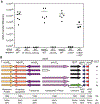Intercellular communication and conjugation are mediated by ESX secretion systems in mycobacteria
- PMID: 27846571
- PMCID: PMC8324006
- DOI: 10.1126/science.aag0828
Intercellular communication and conjugation are mediated by ESX secretion systems in mycobacteria
Abstract
Communal bacterial processes require intercellular communication mediated by secretion systems to coordinate appropriate molecular responses. Intercellular communication has not been described previously in mycobacteria. Here we show that the ESX secretion-system family member ESX-4 is essential for conjugal recipient activity in Mycobacterium smegmatis Transcription of esx4 genes in the recipient requires coculture with a donor strain and a functional ESX-1 apparatus in the recipient. Conversely, mutation of the donor ESX-1 apparatus amplifies the esx4 transcriptional response in the recipient. The effect of ESX-1 on esx4 transcription correlates with conjugal DNA transfer efficiencies. Our data show that intercellular communication via ESX-1 controls the expression of its evolutionary progenitor, ESX-4, to promote conjugation between mycobacteria.
Copyright © 2016, American Association for the Advancement of Science.
Figures



Similar articles
-
ESX-1-Independent Horizontal Gene Transfer by Mycobacterium tuberculosis Complex Strains.mBio. 2021 May 18;12(3):e00965-21. doi: 10.1128/mBio.00965-21. mBio. 2021. PMID: 34006663 Free PMC article.
-
Direct cell-cell contact activates SigM to express the ESX-4 secretion system in Mycobacterium smegmatis.Proc Natl Acad Sci U S A. 2018 Jul 10;115(28):E6595-E6603. doi: 10.1073/pnas.1804227115. Epub 2018 Jun 25. Proc Natl Acad Sci U S A. 2018. PMID: 29941598 Free PMC article.
-
The specialized secretory apparatus ESX-1 is essential for DNA transfer in Mycobacterium smegmatis.Mol Microbiol. 2008 Aug;69(4):794-808. doi: 10.1111/j.1365-2958.2008.06299.x. Epub 2008 Jun 28. Mol Microbiol. 2008. PMID: 18554329 Free PMC article.
-
Progress on the function of Mycobacterium T7SS (ESX) secretion system.Yi Chuan. 2023 Dec 20;45(12):1100-1113. doi: 10.16288/j.yczz.23-188. Yi Chuan. 2023. PMID: 38764274 Review.
-
Modular Organization of the ESX-5 Secretion System in Mycobacterium tuberculosis.Front Cell Infect Microbiol. 2016 May 2;6:49. doi: 10.3389/fcimb.2016.00049. eCollection 2016. Front Cell Infect Microbiol. 2016. PMID: 27200304 Free PMC article. Review.
Cited by
-
Genome-wide Phenotypic Profiling Identifies and Categorizes Genes Required for Mycobacterial Low Iron Fitness.Sci Rep. 2019 Aug 6;9(1):11394. doi: 10.1038/s41598-019-47905-y. Sci Rep. 2019. PMID: 31388080 Free PMC article.
-
Extended insight into the Mycobacterium chelonae-abscessus complex through whole genome sequencing of Mycobacterium salmoniphilum outbreak and Mycobacterium salmoniphilum-like strains.Sci Rep. 2019 Mar 14;9(1):4603. doi: 10.1038/s41598-019-40922-x. Sci Rep. 2019. PMID: 30872669 Free PMC article.
-
Population Structure and Local Adaptation of MAC Lung Disease Agent Mycobacterium avium subsp. hominissuis.Genome Biol Evol. 2017 Sep 1;9(9):2403-2417. doi: 10.1093/gbe/evx183. Genome Biol Evol. 2017. PMID: 28957464 Free PMC article.
-
Mycobacterium tuberculosis Toxin CpnT Is an ESX-5 Substrate and Requires Three Type VII Secretion Systems for Intracellular Secretion.mBio. 2021 Mar 2;12(2):e02983-20. doi: 10.1128/mBio.02983-20. mBio. 2021. PMID: 33653883 Free PMC article.
-
ESX-1-Independent Horizontal Gene Transfer by Mycobacterium tuberculosis Complex Strains.mBio. 2021 May 18;12(3):e00965-21. doi: 10.1128/mBio.00965-21. mBio. 2021. PMID: 34006663 Free PMC article.
References
Publication types
MeSH terms
Substances
Grants and funding
LinkOut - more resources
Full Text Sources
Other Literature Sources

